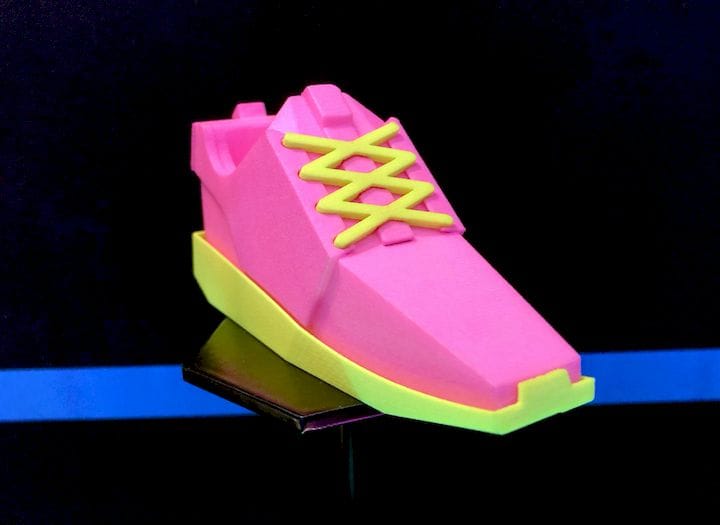![A neon colored 3D print made by DyeMansion [Source: Fabbaloo]](https://fabbaloo.com/wp-content/uploads/2020/05/dyemansion-neon-shoe-1_img_5eb0955fb304b.jpg)
I spoke with DyeMansion’s Chief Customer Officer, Kai Witter, about the company’s new advanced 3D print color systems.
DyeMansion is a German company specializing in post-processing 3D prints. They offer a complete set of equipment and software to perform the three most frequently performed post-processing activities for 3D prints, including: support removal, surface smoothing and coloration.
It’s that last one that interests me today. Coloration in industrial 3D printing is a bit different than what is done in professional desktop 3D prints, where you must pick the color as the input material: you want a blue print? Pick a blue filament.
That’s not the case in industrial 3D printing, where the parts produced must very precisely match color specifications. The coloration must be virtually identical among all parts produced, as we’re talking about production systems here.
![Some of DyeMansion’s consistent 3D print dyes [Source: Fabbaloo]](https://fabbaloo.com/wp-content/uploads/2020/05/image-asset_img_5eb095601145c.jpg)
Dyeing 3D Prints
Most often this is done by dyeing the printed parts, which are typically made in a neutral (white) color. Print first, color with precision later. Thus we’re talking about prints that come off SLS machines or HP equipment: 3D prints that are porous and able to absorb dyes in a consistent manner.
You may think coloring a print is a simple matter, but it is not. There is just as much science involved in dyeing as there is in producing the part in the first place. DyeMansion has been doing this research and has produced a large selection of colors that can be consistently used by their clients.
![3D printed tabs with DyeMansion’s new neon colors [Source: Fabbaloo]](https://fabbaloo.com/wp-content/uploads/2020/05/image-asset_img_5eb09560598f3.jpg)
Recently they’ve managed to develop a set of neon colors that can be used by clients. These colors are absurdly brilliant and while I’ve managed to capture some images of parts using their neon system, they simply don’t reveal what you actually see with your eyes. These prints are incredibly brilliant and even more so when lit with a dose of UV light.
Bright Neon 3D Prints
![A set of brilliantly colored neon 3D prints by DyeMansion [Source: Fabbaloo]](https://fabbaloo.com/wp-content/uploads/2020/05/image-asset_img_5eb095609997b.jpg)
The key to this product is that these neon colors can be consistently applied to 3D printed parts, over and over, making it possible to perform production runs for larger quantities and still maintain color quality.
But another aspect of the discussion with Witter was quite interesting. It seems that DyeMansion, like many other 3D print companies, seeks to do more business with the automotive industry. But as you might imagine, you cannot do so without strong evidence that you can meet a number of standards for quality and performance, as these manufacturers must be able to deliver consistent products in massive quantities.
DyeMansion’s efforts to break into the automotive industry started with plain black. This seemed quite surprising to me, as you might think the automotive folks would be most interested in having a variety of colors. In fact, not that many black cars are produced.
Automotive 3D Print Colors
![Black-dyed 3D prints by DyeMansion showing effects of irradiation [Source: Fabbaloo]](https://fabbaloo.com/wp-content/uploads/2020/05/image-asset_img_5eb09560e5c1f.jpg)
I did not realize there were color standards for black! Here we see some samples of black colors made by DyeMansion for this purpose. The standards are not only for the visual aspects, but also for wear-and-tear. In this sample we see how the color very subtly changes after the specific light exposure from the left to the right.
DyeMansion’s “Automotive Black” shows very little change after irradiation, meaning it has likely met the standards and thus would be suitable for use in automotive applications.
But it turns out the game here is really to demonstrate to the automotive industry that you are capable of meeting the standard. Once you’re involved then the automotive companies will request the custom colors we’ve all come to love in our vehicles. You just start with black.
It seems that DyeMansion is succeeding in their efforts to enter the automotive market, and thus we may be seeing more colorful 3D printed parts in automobiles of the future.
Via DyeMansion











If you’re a youngin’ whose neurons have just myelinated or an educator who’s responsible for bludgeoning their brain tissue with knowledge, there’s a 3D printer option you’ll want to add to your lab list – A RIZE 3D Printer.